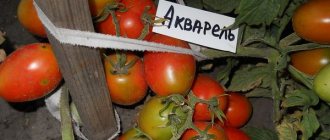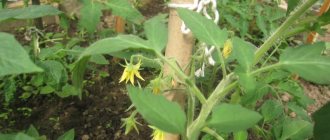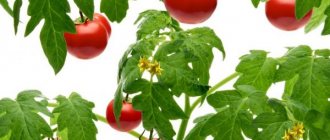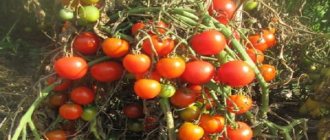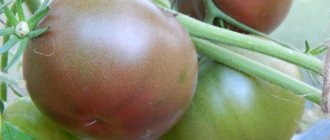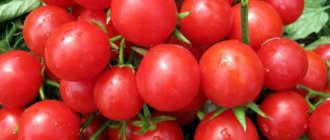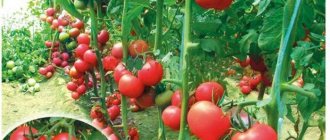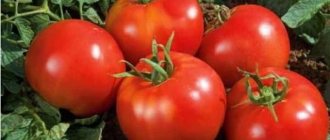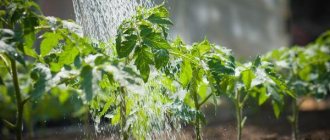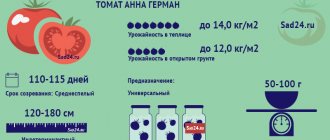History of creation
Hybrid Rosemary (the more correct name is Rosamarin f1) was bred by biologists of the Research Institute for Breeding Vegetable Crops and Agricultural Firm Gavrish in 2003.
Included in the State Register of Breeding Achievements of the Russian Federation in 2004. Approved for cultivation in all regions of the country in open ground under temporary shelter and in film-type greenhouses. The hybrid is specially bred for spring-summer rotation.
In the photo - tomato Rosemary f1.
Growing crops and caring for bushes
The sample is grown using seedlings, like other varieties. Determining the timing of planting seeds for seedlings is an individual matter and depends on climatic conditions. In general, superelite is planted between March and April.
After the appearance of several true green leaves, the mouras dive. From this moment until planting in a permanent place of growth, about 60 days pass. Before planting in open ground, it is recommended to harden the seedlings so that the plants better adapt to new growth conditions. More than three bushes are placed uninhabited (= sparsely populated) per 1 m2.
Care is normal and includes simple procedures such as:
- Watering with water at room temperature, preferably in the evening, once every 5 days.
- After watering, loosen the soil so that it does not become compacted. The roots must take in enough air.
- Application of complex fertilizers.
- Mandatory garter and stepson.
- This care procedure is simple and familiar to every vegetable grower. For a summer resident with experience, growing the Rosemary variety will not be difficult.
“Rosemary” is a good quality plant that has already proven itself for its productivity, quality, taste of fruits, and, again, ease of care.
Description of the hybrid
The table summarizes the distinctive features of tomatoes.
| Indicators | Characteristic |
| Weight | 250-350 g |
| Form | Flat-round, slightly ribbed. |
| Coloring | Pink, with a dark green spot near the stalk. |
| Leaves | Large, dark green. |
| Type of inflorescences | Simple. |
| Number of ovaries | Five or more. |
| peduncle | With articulation. |
| Number of slots | More than four. |
| Pulp | Juicy, soft, sugary, with a pronounced “tomato” aroma and a small number of seeds. |
| Taste | Sweet, pleasant. |
| Skin | Thin, shiny, prone to damage. |
| Purpose | For fresh consumption. |
| Bush | Indeterminate, 1.5 – in open ground, 1.8-2 m – in closed ground. |
| Ripening period | 112-120 days from the moment of emergence. |
| Productivity | 9-13 kg/m² or 4-5 kg per bush. |
| Sustainability | To viral diseases. |
| Transportability | Low. |
Reference. The pulp of Rosemary fruit contains twice as much vitamin A as compared to other tomatoes.
Tomato Rosemary: variety description
The Rosemary tomato is a mid-season variety. It takes 113-116 days from planting seeds to harvesting the first ripe fruits .
It is recommended to grow in greenhouses; when planting on open ridges, the bushes require temporary film cover. Bushes with a large number of leaves, a characteristic shape for tomatoes, dark green in color.
Reaches a height of 120-130, but with good care up to 180 centimeters. High resistance to major tomato diseases . Growing requires light, fertile soil. With excessive application of organic fertilizers, curling of the leaves on tomato bushes is observed.
Read more about soil for seedlings and for adult plants in greenhouses. We will tell you about what types of soil for tomatoes exist, how to prepare the right soil yourself, and how to prepare the soil in the greenhouse for planting in the spring.
Due to their large weight (up to 550 g), Rosemary tomatoes require the formation of a bush on a trellis with the obligatory tying of the trunk and clusters of fruit. It is recommended not to plant more than three plants per square meter. With a lack of moisture, cracking of the fruit is observed.
You can compare the weight of fruits with other varieties of tomatoes in the table below:
| Variety name | Fruit weight |
| Rosemary | up to 550 grams |
| Bobcat | 180-240 grams |
| Russian size | 650 grams |
| King of Kings | 300-1500 grams |
| Long Keeper | 125-250 grams |
| Grandma's gift | 180-220 grams |
| Brown sugar | 120-150 grams |
| Rocket | 50-60 grams |
| Altaic | 50-300 grams |
| Yusupovsky | 500-600 grams |
| De Barao | 70-90 grams |
When growing tomatoes, it is important to know what type of plant each variety belongs to. Read all about indeterminate varieties, as well as determinate, semi-determinate and super-determinate varieties.
Advantages and disadvantages
Benefits of culture:
- large fruits;
- excellent taste and aroma;
- uniformity of fruit size;
- strong trunk structure;
- resistance to nightshade diseases and insect attacks;
- high vitamin A content;
- suitable for dietary nutrition.
Flaws:
- low level of shelf life and transportation;
- thin skin cracks due to lack of moisture;
- tomatoes are not suitable for pickling and salting;
- requires film cover in open ground;
- tall bushes need pinching and staking.
Advantages and disadvantages of the variety
Summer residents value Rosemary tomatoes for their large, sweet and juicy fruits. If you provide normal care, you can get a lot of tomatoes during the season, which are well suited for personal consumption and for sale.
The tomato variety Rosemary is characterized by high yield
pros
- high productivity;
- the bushes are strong, the branches do not break;
- tomatoes are tasty and juicy;
- resistance to major diseases;
- attractive appearance;
- high concentration of vitamin A.
Minuses
- Rosemary tomatoes are not suitable for whole-fruit canning;
- needs to be pinched and tied up;
- You cannot grow bushes from your own seeds, since this is a hybrid, not a variety;
- keeping quality and transportability are not very good - the skin may crack.
Tomato agricultural technology
Growing rules are standard, as for all indeterminate hybrids:
- tomatoes are grown through seedlings;
- planting is carried out in well-heated soil;
- bushes are pinched and tied to supports or trellis;
- provide moderate watering with warm water;
- the soil is periodically loosened or covered with mulch;
- fertilize with complex fertilizers.
Seed preparation
Hybrid seeds do not require additional disinfection, since they are processed in production. To increase the percentage of germination, grains are soaked in ready-made growth stimulants - “Epin”, “Immunocytofit”, “Zircon” or use natural remedies:
- Juicy aloe leaves are kept in the refrigerator for 24 hours, then the juice is squeezed through cheesecloth and diluted with water 1:1. The seeds are soaked in the solution for 4-6 hours. In addition to stimulating germination, aloe improves plant immunity.
- A handful of onion peels and 1 tsp. wood ash pour 500 ml of boiling water and leave for three days. Before use, strain and soak the seeds in the infusion for 2-4 hours.
- Dissolve 1 tsp in a glass of warm water. natural honey. Soak the seeds for 5-6 hours.
Important! Before processing in stimulants, the seed is soaked in melt water at room temperature until it swells.
The soil
A mixture of turf, peat and humus in a 1:1:1 ratio is ideal for growing seedlings.
Before use, the substrate is calcined in the oven at a temperature of 100-110 ° C or steamed in a double boiler for an hour.
Sowing
Sowing is done in the last week of March or early April. The seedling boxes are filled with a moist substrate and the seeds are placed in furrows 1.5 cm deep at a distance of 2 cm. Cover the top with a 1 cm layer of soil and cover with glass or film.
The boxes are taken to a dark, warm place. The optimal room temperature is not lower than +24 °C.
Seedling care
The film or glass is removed after the sprouts appear. The boxes are taken out to a sunny place. The seedlings are watered as needed, after the top layer of soil has dried.
To prevent the development of fungus, seedlings are taken out into fresh air for 20-30 minutes.
After 3-4 true leaves appear, the sprouts are planted in separate containers made of peat or plastic, carefully pinch off the root tip.
Landing in the ground
The transfer of mature seedlings begins 60-65 days after emergence, starting in mid-May. The site is chosen on the sunny side, since productivity decreases in the shade. The best predecessors of tomatoes are radishes, dill, parsley, cabbage.
The culture prefers light, nutritious soil with neutral acidity - pH 7. Dense soil is loosened with river sand or peat. The soil is brought to normal using wood ash or chalk:
- sour – 400-500 g per 1 m²;
- medium-sour – 200-300 kg 1 m²;
- slightly acidic – 200 g per 1 m².
Holes for seedlings are dug at a depth of 15-20 cm and filled with a strong solution of potassium permanganate, add 1 tbsp. l. superphosphate. The seedlings are watered abundantly with warm water and transferred together with an earthen lump from a plastic container or planted directly in a peat glass.
There are no more than three bushes per 1 m². Planting pattern – 40x60 cm.
Care
The culture does not require care; it prefers moderate watering and fertilizing with mineral compounds.
Rules of care:
- The humidity level in the greenhouse should not exceed 70%.
- It is undesirable to overwater the soil and at the same time allow it to dry out. The best solution to the watering problem is to install a drip system.
- Rain or settled water is used for irrigation.
- The bushes are pruned once every 10 days and formed into two stems.
- At the end of the growing season, pinch off the top. The plant will stop growing, and all the energy will go to the tomatoes.
- They tie up not only the stems, but also the flower clusters, which can break under the weight of the fruit.
- After watering, the soil is loosened to prevent the formation of a hard crust.
Advice . Cover the soil with mulch (sawdust, straw, hay, synthetic black agrofibre) to eliminate routine weeding and loosening, retain moisture and prevent fungal infection.
Top dressing
Tomatoes are fed at least three times during the growing season according to the following scheme:
- The first organic feeding 14 days after planting is chicken manure with the addition of water in a ratio of 1:10 or ready-made products: “Gumisol”, “Veromistin”.
- The second feeding 14 days after the first - with complex fertilizer “Solution” containing calcium, manganese, potassium and phosphorus. For 1 bush – 2 liters of solution.
- The third subcortex during the period of fruit appearance is “Solution”, 2.5-3 liters for each bush.
Growing difficulties
Tomatoes are sensitive to both deficiency and excess of mineral components. By the appearance of the bushes it is easy to determine the condition of the plant:
- It gains green mass, but does not bloom - there is an excess of nitrogen in the soil. Wood ash will help reduce its amount.
- The bushes stretch upward, the leaves turn pale - nitrogen deficiency.
- Leaves acquire a purple tint when there is a deficiency of phosphorus, and fall off when there is an excess of it.
- The green mass becomes dull when there is an excess of potassium and dries out when there is a deficiency.
Landing
Tomatoes are grown in seedlings.
The key to success is high-quality seed purchased from a trusted manufacturer. At the end of March, pre-planting preparation of seeds is carried out: dressing in a solution of potassium permanganate (1%) and preparing the soil mixture - a mixture of humus and peat, heated in the oven at 100-110 °C.
In early April, the soil substrate is poured into a planting container, shallow grooves (1.5-2 cm) are made in one direction, and water is spilled.
To speed up germination, seeds are treated with growth stimulants before sowing.
Tomatoes are sown at a distance of about 1.5-2 cm from each other, sprinkled with a minimum layer of soil mixture and covered with film or glass until shoots appear. The soil should always remain moist and warmed by the sun to 24-25 °C.
The soil should be moist and warm
After the emergence of seedlings, the shelters are removed and the temperature in the room is gradually lowered. At the stage of 3-4 true leaves, the seedlings are planted in individual containers.
The final planting to a permanent place in the greenhouse is carried out in May, at an air temperature of at least + 10 °C. It should be borne in mind that Rosemary F1 tomatoes, by all descriptions, are very powerful plants; seedlings must be planted at a distance of at least 0.6-0.7 meters from each other. Per square meter of area - no more than 3-4 plants.
Prevention of diseases and pests
Hybrid Rosemary is protected at the genetic level from infection by viral diseases of nightshades (verticellosis, fusarium, tomato mosaic). Seed producers claim that the crop is not afraid of late blight (brown spots, whitish coating on leaves and trunks, ugly shape of fruits).
However, prevention will not be superfluous:
- soil treatment with copper sulfate;
- disinfection of greenhouses with sulfur bombs;
- removing lower yellowed leaves;
- control of moisture level in the greenhouse;
- moderate watering at the root;
- covering the soil with mulch.
The main problem that gardeners face when cultivating tomatoes is leaf curling. If measures are not taken in time, you may be left without a harvest. The reason for this condition lies in an excess of organic fertilizers in the soil, the air temperature in the greenhouse is above +32 ° C, and a deficiency of copper.
Ways to solve the problem:
- application of phosphorus-potassium fertilizers;
- treatment with the preparation “Agrofon” containing copper;
- ventilation of greenhouses to normalize temperature conditions.
The hybrid is often attacked by mole crickets, Colorado potato beetles, whiteflies, aphids, and caterpillars. Modern safe insecticides help fight pests: “Grom”, “Fitoverm”, “Iskra”, “Force”, “Epin”, “Konfidor”, “Commander”.
Basic growing rules
This variety can be grown in open ground, but only in regions with a moderately warm climate. In cool summer conditions and lack of sunlight, it is recommended to grow plants in a greenhouse to avoid loss of yield.
Even with no experience, you can successfully grow Marfa F1 tomatoes and get a good harvest. But if you follow a few of the rules and recommendations described below, the plant productivity will increase several times. Let's take a closer look at the main features of growing Marfa F1 tomatoes.
Growing seedlings
The process of growing Marfa F1 tomatoes begins with proper planting of seeds and caring for seedlings.
The seeds of this variety have good germination, but for the best results it is recommended to carry out several additional steps to prepare them:
- warm the seeds on a radiator for several days, placing them in a small fabric bag;
- disinfect the seeds using a weak solution of potassium permanganate;
- treat planting material with growth stimulants (for example, Epin);
- Dry the seeds slightly at room temperature before planting.
Read more about when and how to plant tomato seedlings correctly.
You can use a ready-made store-bought substrate or prepare the soil yourself from the following components:
- turf land;
- garden soil;
- humus;
- river sand.
Let's look at step-by-step instructions for planting seeds and rules for growing tomato seedlings:
- Make small holes in the soil surface about 1–1.5 cm deep.
- Place the tomato seeds into the prepared holes and sprinkle with a small layer of peat.
- Lightly spray the soil with the seeds with warm water and cover with film. Keep the container in a room with a temperature of about +25 °C.
- After the seeds sprout green shoots, remove the film. Place the seedlings in a well-lit place with an air temperature of about +16°C for about 1 week. Then increase the air temperature in the room with the seedlings to +22°C.
- When a couple of green leaves appear on the seedlings, pick the seedlings. Apply complex liquid fertilizer.
- As the top layer of soil dries, moderately water the sprouts with warm water from a watering can. Grow seedlings away from drafts.
Did you know? The leader in growing tomatoes is China. About 16% of the world's total tomatoes are produced here.
Preparing the soil for planting seedlings
It is not recommended to plant tomatoes two years in a row in the same place - this will lead to soil depletion and a decrease in yield. The area for growing plants needs to be changed every year. And in order for the seedlings to take root well on the site and produce a high yield, the soil must first be prepared.
This procedure consists of several stages:
- in the fall, dig up the soil and then pour it with a warm aqueous solution of copper sulfate (1 tbsp of the substance is needed for 10 liters of water);
- in the spring, add organic fertilizer consisting of peat, humus and sawdust with the addition of superphosphate;
- 10 days before planting the seedlings, dig up the area again and treat the ground with a lime solution;
- To disinfect the soil, pour it with a hot solution of potassium permanganate.
Technology of planting seedlings
Young tomato seedlings are usually planted in a greenhouse when the sprouts reach the age of 60–65 days. At this time, the plants have already formed 3-4 pairs of green leaves and at least one flower cluster. Planting of seedlings in open ground is carried out a little later and only after the soil has warmed up sufficiently.
Step-by-step instructions for transplanting seedlings are presented below:
- Dig holes in the soil about 8 cm deep. Place nitrogenous fertilizers at the bottom of the hole.
- Carefully remove the young sprout from the individual container along with the earthen lump.
- Place the seedling in the hole and cover its roots with soil. Lightly compact the soil around the sprout stem.
- If the soil is not moist enough, you can water the seedling at the root with a small amount of warm water.
Important! Planting of seedlings is carried out according to the 50x40 pattern; no more than 3 plants can be placed per 1 m².
Harvest Application
The first fruits appear approximately 112 days after germination. Remove the tomatoes carefully, twisting them from the stalk, being careful not to damage the thin skin. The shelf life is minimal, so they try to use them immediately.
The fruits are eaten fresh. Due to their delicate skin, tomatoes are completely unsuitable for pickling and whole pickling.
Too soft tomatoes are used for adjika, lecho, sauce, juice, tomato paste.
Characteristics
- Hybrid Rosamarin is a mid-season hybrid; ripening occurs 115 days after the appearance of full shoots. But bad weather can delay this moment by a week;
- The marketable yield of Rosemary, according to the State Register, is 9.8 - 12.4 kg per 1 square meter. Although the manufacturer claims the result is slightly lower - 8.0 - 11.0 kg per 1 sq. meters or about 4 kg per plant;
- The variety’s immunity is good, as befits a hybrid plant;
- Unfortunately, thin skin will not save tomatoes from cracking. Therefore, in greenhouses it is necessary to carefully monitor air and soil humidity, maintaining this indicator within normal limits;
- differences in day and night temperatures negatively affect the plant as a whole, so on warm days the edge of the shelter must be raised and lowered at night;
- Transportability is not very good, especially for large tomatoes, they become wrinkled and their presentation is lost. Keeping quality is also a problem. It is advisable to immediately use the Rosamarin harvest for food or process it;
- According to its intended purpose, the delicate product belongs to the salad category and is recommended for baby and dietary food. It is also suitable for processing into tomato products - sauces, juices. But the variety is not suitable for pickles and canning.
Reviews
Gardeners' impressions of growing this large-fruited hybrid are mostly positive.
Elena, Kstovo: “Before deciding to grow Rosemary tomatoes, I read the reviews of those who planted them. Inspired, I purchased the seeds. The characteristics and descriptions of the tomatoes on the packaging are true. The seedlings grew strong, I didn’t feed them with anything. I moved it to the greenhouse in early June. Fertilizers included chicken manure and potassium-phosphorus fertilizers. I watered it with warm water once a week under the bush. During drought, the frequency was increased to two waterings. The harvest was a great success; I have never eaten tastier tomatoes.”
Yaroslav, Borisoglebsk: “Last year I tried to grow Rosemary in the garden, before that I planted it in a greenhouse. The bushes are strong, with thick stems, tall. I tied it to wooden stakes and covered it with foil in extreme heat. I didn’t notice any special problems with care. The main thing is to water and feed in moderation. The tomatoes grew large, fleshy and very sweet.”
Compared to other varieties
There is a variety (namely a variety, not a hybrid) with a similar name - “Pound Rosamarin”. It also belongs to the category of mid-season and indeterminate, has been listed in the State Register since 2008 and is recommended for cultivation in the same regions. Rosamarin pound differs from the described hybrid in that it is more “flattened” and has pronounced ribbing of the fruit; its yield is somewhat lower (7.9 kg/m²), but the tomatoes are larger (400–500 g).
Tomato Rosamarin pound, unlike Rosemary F1, is not a hybrid, but a variety
In general, pink tomatoes have recently become a real trend among Russian gardeners. Therefore, there are quite a lot of varieties. Most popular:
- Anna. Mid-early semi-determinate variety. Suitable for cultivation in open ground and in greenhouses. The height of the bush rarely exceeds 1.5 m. The fruits are round-heart-shaped, weight varies greatly (100–300 g). The pulp is sweet, very juicy, there are few seeds.
Anna tomatoes have an advantage over the Rosemary F1 hybrid - they can also be grown in open ground
Harvest and storage
Harvesting the fruits of this variety begins at the end of July and continues until mid-September. Tomatoes must be stored in a clean, dry box, where they are carefully placed in several rows. The top of the fruit is covered with a lid to avoid damaging it.
Important! Tomato harvesting should be done every 4 days to prevent rotting and cracking of overripe fruits, as well as to allow unripe vegetables to grow stronger and gain nutrients.

